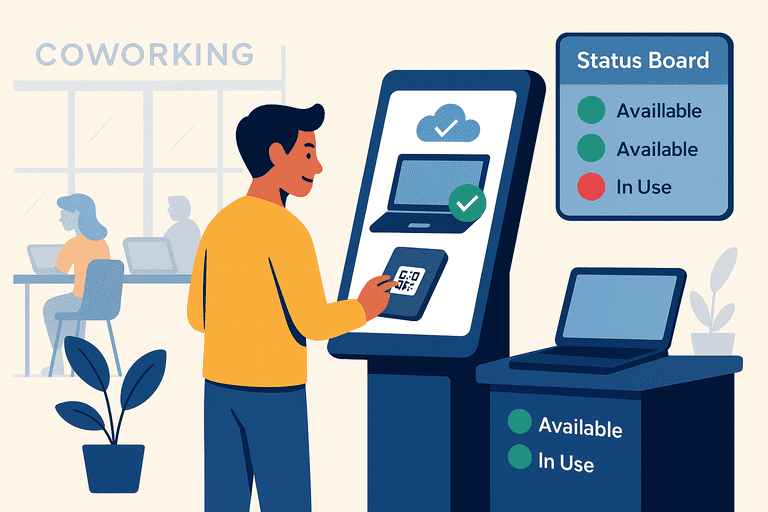Self-Service Kiosks for Asset Checkout in Shared Spaces
Discover how self-service kiosks transform shared workspaces by automating asset checkout, improving accountability, and reducing administrative overhead.

Introduction
In coworking spaces, labs, and creative studios, shared resources are part of daily operations.
But when assets like laptops, projectors, or tools constantly circulate between people, manual checkouts quickly become a bottleneck.
That’s where self-service kiosks come in — offering an automated, touch-friendly way for users to check in and out equipment without staff supervision.
This article explores how kiosk-based systems improve efficiency, accountability, and user experience in shared environments.
1. What Are Self-Service Asset Kiosks?
A self-service asset kiosk is a digital station (tablet or touchscreen terminal) that allows users to:
- Scan a QR or NFC tag on an item
- Authenticate their identity
- Check the asset in or out
- View current availability and due times
It functions as a digital gatekeeper for shared inventory — tracking usage in real time.
2. Why Shared Spaces Need Automated Checkout
Shared spaces like coworking hubs, universities, and workshops often face the same pain points:
- Lost or misplaced assets
- Manual logs that go unfilled
- Lack of visibility over who’s using what
- Admin overload managing reservations
Kiosks eliminate these issues by turning the process into a self-service experience:
- Employees or members scan and confirm asset use directly.
- The system logs every transaction with timestamps.
- Managers monitor everything from a central dashboard.
3. Core Components of a Self-Service Checkout Station
| Component | Description | Example |
|---|---|---|
| Touchscreen Interface | The main station where users interact. | Mounted tablet or wall terminal |
| QR/NFC Scanner | Reads asset tags for fast identification. | USB or embedded scanner |
| Authentication System | Confirms user identity. | Badge swipe, PIN, SSO login |
| Software Integration | Connects to the main inventory system. | Cloud or local network |
| Visual Indicators | Lights or icons showing availability status. | Green = available, Red = in use |
When combined, these tools enable autonomous but traceable access to shared equipment.
4. UX Design Principles for Kiosk Interfaces
A kiosk must be:
- Simple: No deep menus or typing required
- Fast: Check-in/out should take <10 seconds
- Accessible: Large buttons, clear feedback, and multi-language support
- Error-Proof: Show visual confirmations and status alerts
Design the flow for real users — often busy, in a rush, and using the kiosk while carrying equipment.
5. Benefits of Self-Service Asset Kiosks
| Benefit | Description |
|---|---|
| Reduced Administrative Load | Users handle their own checkouts. |
| 24/7 Access | Equipment can be borrowed anytime. |
| Improved Accountability | Every action is logged and traceable. |
| Faster Turnaround | Streamlined process eliminates wait times. |
| Enhanced Transparency | Managers see asset status in real time. |
These systems also increase user satisfaction, as staff no longer act as gatekeepers — they focus on higher-value tasks instead.
6. Integration with Existing Systems
For maximum efficiency, kiosks should connect with:
- Access control systems (badges or cards)
- Inventory databases (for item status)
- Calendar or booking tools (for reservations)
- Maintenance alerts (when an item requires service)
A well-integrated kiosk acts as both a frontline access point and a data capture node for the wider ecosystem.
7. Deployment Scenarios
Self-service kiosks are ideal for:
- Coworking spaces managing shared laptops, cameras, or chargers
- Universities with AV or lab equipment
- Workshops loaning tools or materials
- Corporate offices managing pool assets like tablets or meeting kits
They scale easily — from a single kiosk per floor to a network across multiple locations.
8. Security and Compliance Considerations
Kiosks should comply with both IT and data protection policies:
- Role-based permissions restrict who can borrow specific assets
- Audit trails record each transaction for compliance
- Automatic session timeouts protect unattended screens
- Data encryption ensures safe transmission to the cloud
Physical placement also matters — kiosks should be located near shared storage areas to minimize risk of misuse.
Conclusion
Self-service kiosks represent the next step in shared inventory management — combining convenience, automation, and accountability.
They help spaces operate efficiently while empowering users to take responsibility for shared resources.
For modern workplaces, automation isn’t just a luxury — it’s a scalable necessity.
Explore more articles on automation and shared resource management: